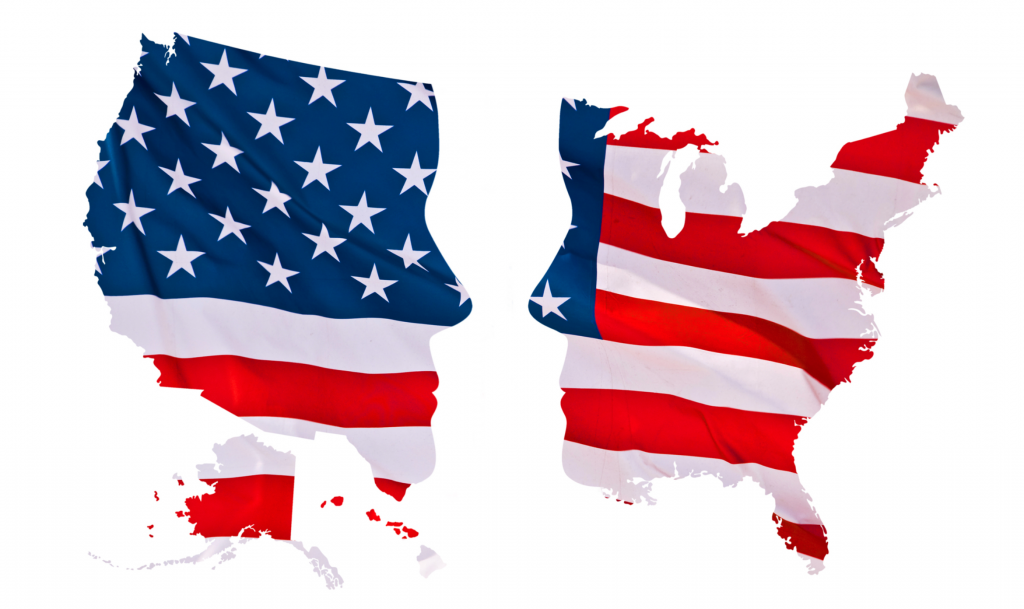

Is a “national divorce” really our next best move?
A former professor of mine once observed that troubled couples have three options. They can either bail out, stick it out, or work it out.
By the time troubled couples come to see me—a psychologist—they’ve often been sticking it out for so long that working it out seems like a pipedream. They view counseling as a last gasp attempt to revive a marriage that died a while back—like administering CPR to a person who appears to be dead.
Toward the end of our initial session, couples usually hear me saying something like this:
You guys have some long-standing issues you’ve never been able to resolve. But I’m convinced of this: Issues don’t split couples up. Their inability to resolve issues splits them up.
Some people have major differences but good relationships because they’ve learned how to resolve things. Others have piddly differences but bad relationships because the process they’ve been using to resolve issues leaves everything unresolved.
So, I’d like to help you change your resolution process—from one that fails to one that succeeds. If we only focus on the issues, nothing will change. But if we change the process, then you can start resolving your issues.
You know that look a dog gives you when you say something it doesn’t understand and it cocks its head to the side? That’s the way couples look at me when I finish my spiel. But it makes sense once they see it happening.
Recently, a member of Congress suggested (via tweet) that we may need a “national divorce” (whatever that means). The idea was that since political opponents can’t work it out and many are fed up with sticking it out, we might just have to bail out.
That tweet brought to mind something you may have heard of called “horseshoe theory.” Let me explain.
We’ve traditionally pictured the political spectrum as a horizontal line with the Far Left on one end and the Far Right on the other. In the middle are the Center Right and Center Left. In more normal times, a scatter plot would depict the biggest clusters around the middle of the spectrum with less populated clusters on the ends.
But in recent years, studies suggest that the ends of the spectrum are becoming more populated while the middle numbers are declining. In short, we’re becoming more polarized, with some suggesting that we’ve not been this divided since the 1850’s—and we know what happened in the 1860’s.
Horseshoe theory posits that with heightened polarization, the political spectrum is best depicted not as a horizontal line but as a horseshoe, with centrists in the wide rounded top and extremists in the ends that bend close to each other at the bottom. The ends, while differing greatly on issues, are very similar in terms of the process they use to address differences. The process used by centrists at the top is also similar.
Picture that horseshoe and draw a vertical line through the center, evenly dividing the two halves. Those on the left side have policy differences with those on the right side. In other words, left and right are divided by issues.
Now, erase your vertical line and draw a horizontal line dividing the top from the bottom. Those at the top of the horseshoe use a process for resolving differences very unlike the one used by those on the two ends at the bottom. In other words, up and down are divided by process.
Those at the top are committed to getting along despite their differences. Those at the bottom have no intention of getting along. Instead, they line up across from each other like combatants on an eighteenth-century battlefield. Those at the top want to work it out. Those at the bottom may consider bailing out—or getting a “national divorce” and then blaming the breakup on the other side.
The most important division in our country right now is not between Left and Right. It’s between Up and Down. Up is potentially restorative. Down is assuredly dangerous.
What follows are some ways these two processes vary. “Up” is shorthand for the process used by centrists at the top. “Down” is shorthand for the process used by extremists on the two ends at the bottom of the horseshoe.
***
Up is consistent with the ideals expressed in America’s founding documents which laid out a system for resolving differences that didn’t involve killing people. While the articulation of those ideals has sometimes exceeded their implementation, at least they’ve served as a reference point for what needs self-correction.
Down is consistent with the ways of authoritarian regimes that resort to violence against those who disagree. In this view, “working it out” is a fool’s errand and nothing more than aspirational naivete.
***
The humble stance of Up: “I could be wrong, you could be right. Let’s talk.”
The arrogant stance of Down: “I’m right, you’re wrong. End of discussion.”
***
Up looks for compromises in which both sides give up a little in order to gain much of what they want.
Down sees compromise as a dirty word and opts instead for a winner-take-all, zero-sum-game strategy.
***
Up views those on the other side as citizens to be persuaded.
Down views those on the other side as enemies to be defeated.
***
Up holds that if we lose now, we’ll work harder and win later.
Down holds that if we lose now, all that we value will come to an end.
***
Up views those with differing opinions as fellow citizens who hold similar core values while differing on the best ways to pursue those aspirations.
Down holds an “us-versus-them” view in which “they” are devoid of values and seek to destroy ours.
***
Up strives for a more accurate understanding of what’s true. They are largely unthreatened by those with differing opinions and draw conclusions only after considering a variety of alternate viewpoints.
Down is committed to its narrative and filters out any facts that don’t support it. Down starts with conclusions, searches for confirming facts, and then insists that theirs are the only “fact-based” conclusions.
***
Up fears the concentration of power in any one branch of government, preferring instead the constraint of power through checks and balances.
Down is willing to forward undue powers to demagogues to fight for “us” against “them.” Down will cede power to a strongman because, after all, “they” present an existential threat.
***
Up believes that any victory achieved by the sacrificing of one’s principles is hollow.
Down is willing to win first and worry about principles later because, after all, desperate times call for desperate measures.
***
Up views those on the other side as good people with bad ideas.
Down views those on the other side as evil people for having such bad ideas.
***
Up draws inspiration from the words of Abraham Lincoln, who spoke of “the better angels of our nature.”
Down is animated by the words of Lord Voldemort when he told Harry Potter, “There is no good and evil, there is only power, and those too weak to seek it.”
***
Were we to experience a national divorce, Down would be how we got there. Our crisis may indeed be existential but it stems not from the competing issues of the two sides but from the challenge to democracy at the top from the forces of autocracy at the bottom.
So, if someone asks where I stand politically these days, my answer will likely be: “I am a dyed-in-the-wool thoroughgoing Upist.”
You know that look a dog gives you when you say something it doesn’t understand and cocks its head to the side? I’m sure I’ll get that look.
Alan Godwin has practiced as a psychologist in private practice in Nashville, Tennessee for over 30 years. He is the author of How to Solve Your People Problems: Dealing With Your Difficult Relationships (Harvest House Publishers). He also serves on the adjunct faculty of Trevecca University where he teaches doctoral students and has traveled nationally presenting continuing education courses for mental health professionals.
Terrific analysis! the horseshoe analogy seems apt to explain better where we are than a spectrum. I wonder if the bell curve still applies because the ends of the curve are the loudest and that tends to exaggerate their actual numbers.
Hi Ron: This was one of our first experiments with poetry. I hope it worked.